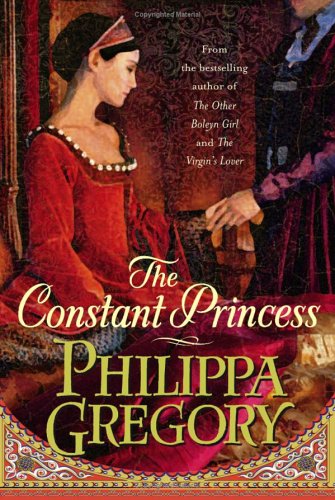 The Constant Princess is part of the Tudor Court series by Philippa Gregory. Although written in 2005, it is chronologically the first book in the series as it deals with Katherine of Aragon, King Henry VII’s first wife.
The Constant Princess is part of the Tudor Court series by Philippa Gregory. Although written in 2005, it is chronologically the first book in the series as it deals with Katherine of Aragon, King Henry VII’s first wife.
Not much is known about this Spanish Princess before she took the throne as Henry VIII’s wife, however Philippa Gregory does an excellent job of filling in the blanks to make the story more personable. We begin at the beginning of her life and carry through to her “delivery” to England to become Arthur’s bride and the Princess of Wales. When Arthur dies quite suddenly, and only six months into their marriage, Catalina (later known as Katherine) makes him a promise: to still become the Queen of England. Historically, this part is a little fuzzy; Catalina and her ladies-in-waiting declare that the marriage to Arthur was not consummated, and begin to set up a marriage to his younger brother, Henry. The rest, as they say, is history.
I enjoyed that the book gave a lot of back-story about Catalina’s life and family before she arrived in England. I didn’t really know much more than she was married to Henry VIII’s older brother first. The only thing that I didn’t care for was as the book got further along in the marriage, it skipped ahead to a scene at Katherine’s trial and then it ended. In the Author’s Note, Philippa Gregory explained that she already went into depth of that part of the story in The Other Boleyn Girl and just wanted to show a glimpse of Katherine’s strength during the trial. Although I’ve already read The Other Boleyn Girl, I wasn’t impressed with this ending; it reminded me a lot of the last Harry Potter book, “19 years later”. It felt like a cheap way out.
As a character and a woman I really enjoyed Katherine of Aragon. Learning about her strength as a “forgotten” Dowager Princess between Arthur’s death and Henry’s marriage was really interesting. The novel also interspersed Katherine’s personal commentary (diary?) with the narrative of the story.
Overall, I think it is Philippa Gregory’s style of writing that I am attracted to. On her website, she makes the following observations:
With the Tudor novels, I am experimenting with a new way of approaching historical fiction which has become identified as my style. It is based on rigorous historical research which forms the basis of the story, and then written in the first person, often in present tense, in an attempt to take the reader into the real world of the Tudor court in an immediate and engaging way.
Readers understand that the books are fiction: we cannot know what someone, dead five centuries ago, was thinking and feeling. But this style is a doorway to the imagined consciousness of the period and has been a joy for me, and for many millions of readers.






January 4, 2009 at 7:24 pm
I’ve been wanting to read this one. I read The Other Boleyn Girl awhile ago and thought it was good, but admit to not being overly impressed with it. I think that’s why I haven’t been so quick to try something else by the author, Still, this and one other of her books have caught my eye and I do hope to someday get to those. Thanks for the great review!
January 5, 2009 at 7:06 am
Oooh, I really enjoy that series! I’ll have to add this to my reading list.
January 5, 2009 at 9:41 am
At some point, I started reading one of her novels (though I can’t even tell you which one) and I was seriously bored, giving up on chapter 3. Still, I do like the period and am curious. At some point, I hope to give Gregory another shot.
That said, I do love The Tudors…
January 6, 2009 at 12:10 pm
Excellent review. I love how you integrated text from the author’s website. That’s something I should add to my blog improvement goals!